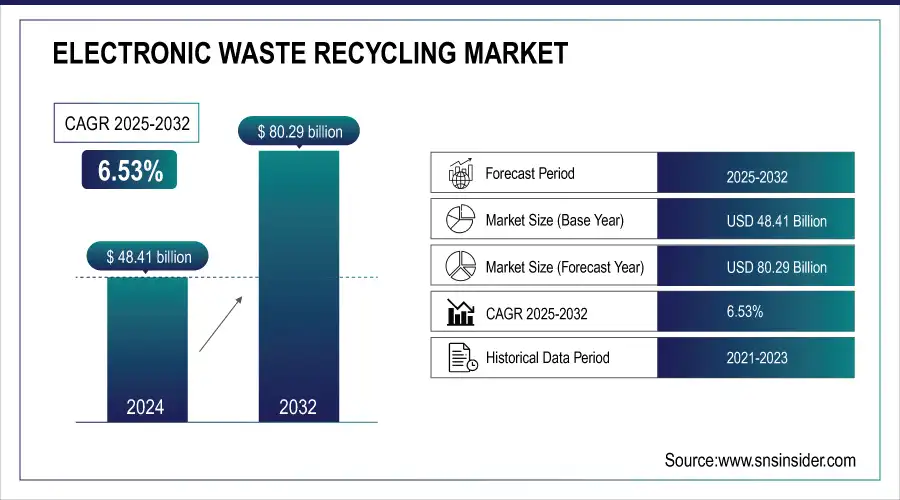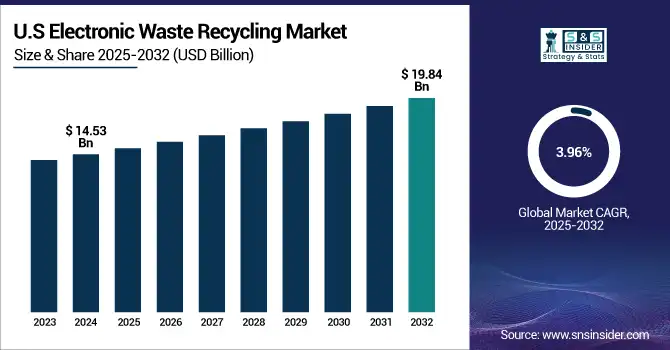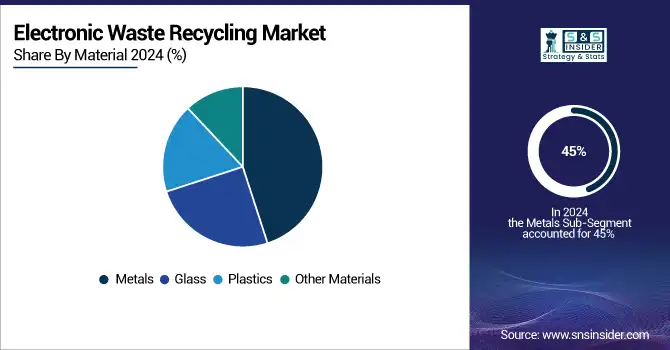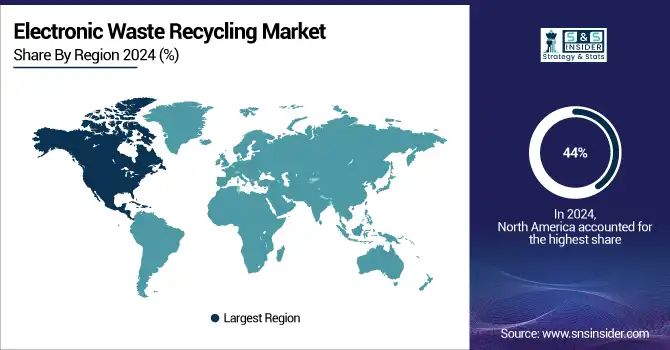Electronic Waste Recycling Market Size Analysis:
The Electronic Waste Recycling Market size was valued at USD 48.41 Billion in 2024 and is projected to reach USD 80.29 Billion by 2032, growing at a CAGR of 6.53% during 2025-2032.
The Electronic Waste Recycling market is experiencing strong growth driven by increasing volumes of discarded electronics, growing environmental conservation standards and regulations. The increasing awareness of recycling, including sustainable IT asset disposition (ITAD), secure data destruction and re Material recovery is causing domestic companies, enterprises and public institutions to take certified-recycling measures. Operational efficiency and transparency within the sector are being overhauled by the adoption of advanced technology solutions like artificial intelligence for diagnostics, supply chain logics optimization, tracing an asset in real-time and through entire supply chains. With certifications like R2v3, ISO 9001, ISO 14001 and ISO 45001 becoming industry staples, the tangible shift toward standardized and zero-landfill recycling methodologies is abroad. Through the increased prevalence of enabling technology and a high (if arguably obfuscated) level of corporate social responsibility, markets are well-placed for further evolution and geographical expansion.

To Get more information on Electronic Waste Recycling Market - Request Free Sample Report
Techbros to Open Artificial Intelligence Powered, R2v3 Certified Electronics Recycling Facility in Arizona; Enabling Enhanced Diagnostic Efficiency and Logistics with Data Security It is promoting sustainable ITAD with zero-landfill policy and transparency in compliance which is an added initiative of the Company.
The U.S Electronic Waste Recycling Market size was valued at USD 14.53 Billion in 2024 and is projected to reach USD 19.84 Billion by 2032, growing at a CAGR of 3.96% during 2025-2032. The growth of his e-waste lifecycle management business is fueled by the rising tide of e-waste generation, environmental regulations getting stricter, and demand for proper handling of old IT assets from sectors such as healthcare, data centers and government agencies. Technological innovations like AI-enabled diagnostic, logistics and asset tracking for operational efficiency and compliance. Consumer awareness and corporate sustainability commitments are fueling growth in the use of certified recyclers, which also means a more circular electronics economy.

The Electronic Waste Recycling market trends include the rising integration of AI and automation for efficient diagnostics, logistics, and data destruction, along with the growing adoption of certified recycling practices like R2v3 and ISO standards. The volume of corporate sustainability goals, and through regulatory compliance has caused an increase in demand for secure IT Asset Disposition (ITAD). Zero-landfill policies, real-time asset tracking and expanding recycling infrastructure beyond regions are further fueling the trend towards a more transparent, efficient and sustainable recycling ecosystem consistent with the principles of the circular economy.
Electronic Waste Recycling Market Dynamics:
Drivers:
-
Community-Led Recycling Programs Spark Growth in E-Waste Recovery Infrastructure
The increasing dominance of local government-led recycling and education initiatives has driven the growth of the Electronic Waste Recycling market. Officials are also helping to ensure that safe e-waste disposal moves forward, through community programs they set up that provide special recycling waste services available for items like electronics, furniture and paint at the same time they create public awareness filled with valuable information. They have gone a long way to raising community consciousness, improving collection rates, and expanding volumes. Linking with schools for outreach ensures that sustainable habits are instiled from a young age, and the widespread availability of collection points and support services guarantee local recycling solutions for stigma-free recycling at the household level. These models are also gaining traction regionally, bolstering local recycling infrastructure and hastening a broader push toward environmental stewardship. Such grass roots movements, are the only means for ensuring a long term growth and impact in e-waste recycling
The Clark County Solid Waste District recycled more than 57,000 tons in the county in 2024 and educational programs to 2,000 students in recycling best practices. That included targeted e-waste recycling, as well as more than 120 classroom programs in order to further countywide sustainability education.
Restraints:
-
Complex Device Structures and High Recovery Costs Limit E-Waste Recycling Efficiency and Market Expansion
The Electronic Waste Recycling market faces significant restraint due to high processing costs and the complexity of recovering valuable materials from mixed e-waste streams. Most electronic devices typically include dangerous materials and complex architectures, which necessitate time-consuming and costly disassembly and material isolation. Material recycling due to varying commodity prices is not always commercial without support pricing for extracted resources such as copper, gold, or rare earth metals. The absence of established norms of product design and recycling legislation disparities amongst countries can impact productivity. Due to low margins, recycling businesses cannot negotiate premium prices, which deters them from expanding and forces them to use outdated methods and less expensive techniques that drive up recycling processing cost. These challenges result to unmitigated growth of the electronic waste recycling industry as profits are reduced and there is no incentive for investing in the enterprise.
Opportunities:
-
Rising E-Waste Volumes and Regulatory Pressures Drive Demand for Scalable Recycling Solutions
The growing amount of e-waste, increasing environmental awareness and stringent regulatory requirements are presenting strong market opportunities for advanced e-waste recycling solutions. With sustainability and circular economy practices now firmly on the agenda in countries around the world, there is a growing need for more efficient recycling infrastructure – automated kind sorting, secure data destruction and high yield material recovery systems. In this context of expanding urbanization, digitalisation and high pace technology development, more and more obsolete electronics end up in landfills due to absence of scalable and compliant recycling operations. Innovative, low-cost and environmentally friendly recycling technologies -- and the businesses that provide them -- will thus be well placed to meet both public sector and private-sector requirements, while communicating an alignment with stronger Government policy settings aimed at reducing reliance on landfills and promoting re-material recovery.
OECD urges Southeast Asia to boost plastic recycling through stronger policies and targeted investments to cut environmental leakage by 95% by 2050.Plastics use in the region hit 152 million metric tons in 2022, with recycling rates needing to quadruple for lasting impact.
Challenges:
-
Global Waste Challenges Underscore Limitations of Traditional Recycling and Drive Demand for Scalable E-Waste Solutions
The growing visibility of plastic and electronic waste accumulation, particularly in regions like South Korea, is highlighting the limitations of current recycling systems. Since many electronic devices contain hazardous substances and complex Material structures, dismantling and material separation are expensive and laborious endeavours. Moreover, the cost of processing is compounded by the fact that the price of recovered materials like copper, gold, and rare earth metals is volatile, making recycling uneconomically viable without subsidies. Efficiency is further inhibited by the scarcity of standardization in product design and recycling rules in various regions. As a result of these difficulties, recyclers’ profit margins are slim, and there is little investment in infrastructure or market expansion. The electronic waste recycling industry’s general growth is limited as a result of these constraints, especially in developing markets where technology and finance are limited.
South Korea under fire over plastic waste build-up as it gears up to host U.N. treaty talks Even with this recycling push, experts caution it can't keep pace with increasing plastic production and call for global limits on plastic manufacturing
Electronic Waste Recycling Market Segmentation Analysis:
By Material
In 2024, the Metals segment accounted for approximately 45% of the Electronic Waste Recycling share, driven by the high recovery value of materials such as gold, copper, aluminum, and palladium found in discarded electronics. The growing demand for re Material recovery, rising metal prices, and increased focus on sustainability have strengthened this segment’s dominance within the recycling industry.
The Plastics segment is expected to experience the fastest growth in Electronic Waste Recycling over 2025-2032 with a CAGR of 9.29% This surge is driven by increasing volumes of plastic Material s in electronic devices and rising environmental concerns. Advances in plastic separation and recycling technologies are further boosting market demand for sustainable plastic recovery solutions.

By Source
In 2024, the Household Appliances segment accounted for approximately 45% of the Electronic Waste Recycling share, driven by the large volume of discarded items such as refrigerators, washing machines, and microwaves. The increasing replacement rate of home appliances, combined with rising awareness of proper disposal practices and regulatory mandates, has significantly boosted recycling efforts within this category.
The It & Telecommunication segment is expected to experience the fastest growth in Electronic Waste Recycling over 2025-2032 with a CAGR of 9.79% This growth is fueled by the rapid turnover of electronic devices like smartphones, laptops, and network equipment, alongside increasing digitalization. Rising e-waste volumes, data security concerns, and stricter compliance regulations are further driving segment demand.
By Technology
In 2024, the Pyrometallurgical Process segment accounted for approximately 45% of the Electronic Waste Recycling share, ue to its efficiency in recovering precious metals such as gold, copper, and palladium from complex e-waste. It has the advantage of being able to treat mixed material streams at high recoveries and scale economically, which makes this a well-utilised approach where industrial-type applications necessitate it.
The Lithium Battery Recycling segment is expected to experience the fastest growth in Electronic Waste Recycling over 2025-2032 with a CAGR of 11.17%, This growth is driven by increasing adoption of lithium-ion batteries in electronics, electric vehicles and energy storage systems. Rising concerns on depleting resources, environmental consequences, and strict regulations related to the disposal of batteries are also pushing the investments in advanced lithium battery recycling technologies.
By End-Use Industry
In 2024, the Automotive segment accounted for approximately 31% of the Electronic Waste Recycling share, due to a growing amount of electronics being added to modern cars. Sensors, control units, infotainment systems and battery packs are therefore among the materials in which e-waste volumes play a significant role. The move towards electric vehicles and increasing regulatory emphasis on recycling end-of-life vehicles are also favouring the market.
The Industrial Equipment segment is expected to experience the fastest growth in Electronic Waste Recycling over 2025-2032 with a CAGR of 8.53% driven by rapid industrial automation, enhanced equipment digitization and need for proper disposal of old machinery. Read more about the regulatory pressure and corporate sustainability goals encouraging increased recycling in this market.
Electronic Waste Recycling Market Regional Outlook:
In 2024 North America dominated the Electronic Waste Recycling Market and accounted for 44% of revenue share, which is mainly due to well-established recycling infrastructure, stringent environmental regulation, and consumer awareness for the proper disposal of e-waste. It has a high number of ITAD providers and there is an increasing sustainability focus that drives the recycling market on a broad scale from residential, commercial, to industrial.

Get Customized Report as per Your Business Requirement - Enquiry Now
Asia-Pacific is expected to witness the fastest growth in the Electronic Waste Recycling Market over 2025-2032, with a projected CAGR of 8.19% This growth is driven by rapid urbanization, rising electronic consumption, and increasing regulatory focus on sustainable waste management. Expanding recycling infrastructure, government initiatives, and growing public awareness across countries like China, India, and Southeast Asia are further accelerating market expansion in the region.
In 2024, Europe emerged as a promising region in the Electronic Waste Recycling Market, supported by stringent environmental regulations, extended producer responsibility (EPR) policies, and strong enforcement of e-waste collection targets. The region’s emphasis on circular economy practices, combined with high consumer awareness and advanced recycling infrastructure, has positioned Europe as a key contributor to global e-waste recovery efforts.
Latin America (LATAM) and the Middle East & Africa (MEA) regions are witnessing steady growth in the Electronic Waste Recycling Market, driven by rising electronic consumption, increasing awareness of environmental impacts, and gradual improvements in recycling infrastructure. The growing number of government initiatives and international support makes the market in these emerging regions to witness expansion, which is further supported by an increasing awareness about sustainable waste management solutions among consumers.
Electronic Waste Recycling Companies are:
The Key Players in Electronic Waste Recycling Market are Dell Inc., Umicore SA, Quantum Lifecycle Partners, Enviro-Hub Holdings Ltd., Kuusakoski Oy, Stena Metall AB, Call2Recycle Inc., Aurubis AG, E-Parisara Pvt. Ltd., ERI, Boliden Group, Attero Recycling Pvt. Ltd., Veolia, SIMS Ltd., Great Lakes Electronic Corporation, TES-AMM, Electrocycling GmbH, Cimelia Resource Recovery, MBA Polymers Inc., Envirocycle Inc. and Others.
Recent Developments:
-
In Jan 2025, Dell's push for modular PC design and renewable materials promotes circularity and extends product life.These innovations support global e-waste reduction by enhancing recyclability and sustainability.
| Report Attributes | Details |
|---|---|
| Market Size in 2024 | USD 48.41 Billion |
| Market Size by 2032 | USD 80.29 Billion |
| CAGR | CAGR of 6.53% From 2025 to 2032 |
| Base Year | 2024 |
| Forecast Period | 2025-2032 |
| Historical Data | 2021-2023 |
| Report Scope & Coverage | Market Size, Segments Analysis, Competitive Landscape, Regional Analysis, DROC & SWOT Analysis, Forecast Outlook |
| Key Segments | • By Material (Glass, Metals, Plastics and Other Materials) • By Source (Household Appliances, Consumer Electronics, It & Telecommunication, Mobile Computing Devices and Other Material) • By Technology(Electrostatic Separation, Pyrometallurgical Process, Hydrometallurgical Process, Lithium Battery Recycling and Other Technologies) • By End-Use Industry(Automotive, Consumer Electronics, Industrial Equipment, Energy & Utilities and Others) |
| Regional Analysis/Coverage | North America (US, Canada), Europe (Germany, UK, France, Italy, Spain, Russia, Poland, Rest of Europe), Asia Pacific (China, India, Japan, South Korea, Australia, ASEAN Countries, Rest of Asia Pacific), Middle East & Africa (UAE, Saudi Arabia, Qatar, South Africa, Rest of Middle East & Africa), Latin America (Brazil, Argentina, Mexico, Colombia, Rest of Latin America). |
| Company Profiles | The Electronic Waste Recycling Market Dell Inc., Umicore SA, Quantum Lifecycle Partners, Enviro-Hub Holdings Ltd., Kuusakoski Oy, Stena Metall AB, Call2Recycle Inc., Aurubis AG, E-Parisara Pvt. Ltd., ERI, Boliden Group, Attero Recycling Pvt. Ltd., Veolia, SIMS Ltd., Great Lakes Electronic Corporation, TES-AMM, Electrocycling GmbH, Cimelia Resource Recovery, MBA Polymers Inc., Envirocycle Inc. and Others. |

